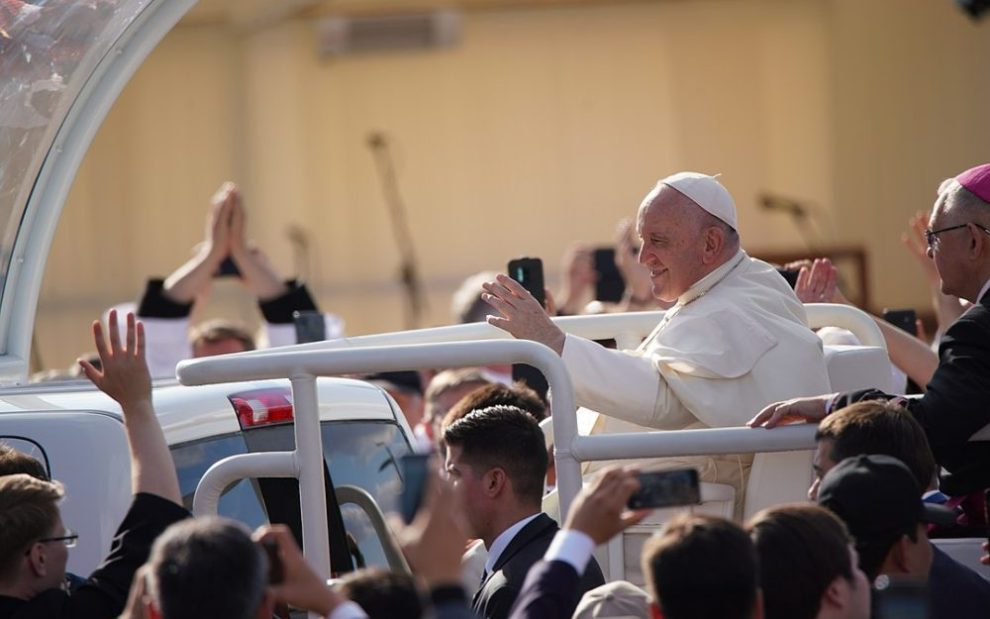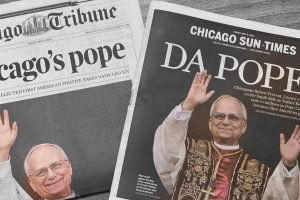Two years after Pope Francis was elected, he told a Mexican television reporter that “I have a sensation that my pontificate will be short; four or five years; or two or three.”
Given that Francis will celebrate the 10th anniversary of his election this March, it’s clear that papal infallibility does not extend to predicting the future. Despite an arthritic knee that often confines him to a wheelchair, Francis shows no sign of slowing down, and his schedule for the next few months is already packed with events.
Ten years of a papacy as energetic as this one is not easily summarized. Those who get their church news from social media might easily conclude the state of the church under Pope Francis is an ecclesiastical civil war, with partisans fighting fiercely with one another about the Latin Mass, human sexuality, and the worthiness of various individuals to receive communion. A closer look at the last 10 years, however, reveals that Pope Francis’s papacy is focused on addressing a much wider range of concerns.
Protecting the vulnerable: a hallmark of this papacy
In responding to clerical sexual abuse, Francis’ performance was initially a bit uneven. He was praised for his 2013 decision to create a Vatican commission focused on the issue. But the commission struggled to operate within the Vatican bureaucracy, and two abuse survivors on the panel—Peter Saunders and Marie Collins—ultimately resigned in frustration.
Francis was also criticized for his public defense of a Chilean bishop who had protected a priest accused of sexual abuse. Although Francis had called the criticism of the bishop “calumny,” he had to walk back that statement after a Vatican investigation substantiated the allegations.
By the end of the decade, the pope seemed to be finding his footing. In 2020, Francis issued Vos estis lux mundi, a document that laid out new procedures governing the investigation of abuse allegations, including those against bishops. The need for the latter had been highlighted by the case of Cardinal Theodore McCarrick, the former archbishop of Washington, DC. Allegations that McCarrick had sexually harassed multiple seminarians became public in 2018, ultimately leading to his dramatic removal from the priesthood a year later.
“Brothers and Sisters All”
Unlike some of his predecessors, Pope Francis has written few encyclicals, the most authoritative statements of papal teaching. The ones he has written, however, have tended to attract widespread attention outside the church. His encyclical Laudato Si’ (On Care for Our Common Home) played an important role in building momentum for the 2015 Paris Climate Accords, an agreement the pope called “historic.”
In 2020, Francis published the encyclical Fratelli Tutti (On Fraternity and Social Friendship), a reflection on what he called “fraternity and social friendship.” Francis used the parable of the Good Samaritan to argue for greater solidarity between nations, cultures, and faiths to meet the global challenges of poverty, migration, and environmental degradation. Issued at a time when political parties based on nationalism and ethnic chauvinism had taken power in countries around the world, Fratelli Tutti was a strong faith-based defense of multicultural democracy and the rules-based international order.
Addressing crimes committed
A key thread of Francis’ ministry has been reckoning with the church’s relationship to colonialism and its impact on indigenous peoples. When Francis attended the Vatican-sponsored World Meeting of Popular Movements in Bolivia in 2015, he asked forgiveness “not only for the offenses of the church herself, but also for crimes committed against the native peoples during the so-called conquest of America.”
The reckoning has not always gone smoothly. Two months after his speech in Bolivia, Francis canonized Franciscan Father Junipero Serra, a 17th century priest who founded several of California’s famous missions. Given the negative impact of the missions on California’s indigenous communities, many Native American organizations were frustrated that the Vatican seemed unresponsive to their efforts to delay or halt the canonization.
In 2022, Francis traveled to Canada to apologize to native communities for the church’s role in forced assimilation through its administration of residential schools. While the apology was well received, many indigenous leaders had hoped that the pope would more explicitly repudiate the 15th century “doctrine of discovery” that had been used to justify the expropriation of native lands.
Francis’ efforts to highlight the value of indigenous culture have also drawn criticism from traditionalists. During the 2019 Synod on the Amazon, a prayer service featuring native traditions led to accusations of “paganism” and “idolatry.” A young Austrian Catholic stole five wooden figures of pregnant indigenous women that had been used in the service and tossed them into the Tiber River. He subsequently posted a video of his efforts on YouTube. In Querida Amazonia, his apostolic exhortation issued after the synod, Francis asked Catholics to “not be too quick to describe as superstition or paganism certain religious practices that arise spontaneously from the life of peoples.”
Pope Francis’ papacy and the challenges of reform
One of the factors that led to Francis’ election in 2013 was the sense among many of the cardinals that the governance structures of the Holy See were in need of reform. While their theological views often differed, virtually all of the cardinals had experienced frustrating encounters with Vatican officials and were angered at the scandals that marked the waning years of Benedict’s pontificate.
Francis initially focused on straightening out the Vatican’s famously tangled finances. In 2014, he established a Council on the Economy—which included both church leaders and financial professionals—to advise him on reforms. While progress has been made in making the Vatican’s finances more transparent, the 2019 revelation that $200 million in church funds had been invested in a risky London real estate deal led many to question how much had changed.
A second pillar of Francis’ reform efforts has been transforming the Roman Curia, the collection of Vatican departments that assists the pope in carrying out his ministry. Last year, the pope issued Praedicate Evangelium (Preach the Gospel), a new constitution for the Curia. In one of the document’s more dramatic moves, it notes that because “the pope, the bishops, and other ordained ministers are not the only evangelizers in the church,”’ any Vatican department can be headed by a layperson.
Potentially the most far reaching of Francis’ reforms has been his efforts to introduce “synodality” into the life of the church. In the early years of his pontificate, Francis focused on making the periodic meetings of the Synod of Bishops more substantive and deliberative. As preparations began for the 2023 synod, Francis decided to extend the process of synodal discernment to the entire church. Listening sessions with ordinary Catholics were held in communities around the world in 2021, the results of which were synthesized at the national and continental levels in 2022. This fall, the Synod of Bishops will convene to begin discussing what has emerged from this collective discernment and its meaning for the church going forward.
A fractured future?
Despite the breadth and depth of Francis’ papacy, most recent press coverage about his pontificate has focused on how the church seems to be polarizing into pro- and anti-Francis camps. Some who took great pride in their “loyalty to the magisterium” during the reign of Pope John Paul II speak of the current pope in ways that would have been unthinkable in the past. A few of Francis’ defenders, by contrast, seem to have forgotten concerns they once expressed about the perils of global papal celebrity and the dangers of conflating the roles of supreme governor, chief theologian, and spiritual leader into a single office.
After 10 years, the broad shape of Pope Francis’ papacy is well defined. The lines drawn by those supportive of and opposed to his reform project are not likely to move much during his remaining years in office. In the same way that Pope Paul VI was forced to navigate the powerful waves of reform stirred up by Pope John XXIII, it may fall to the next pope to determine what aspects of Francis’ legacy will endure.
Image: Wikimedia Commons/Yakov Fedorov (CC BY-SA-4.0)















Add comment